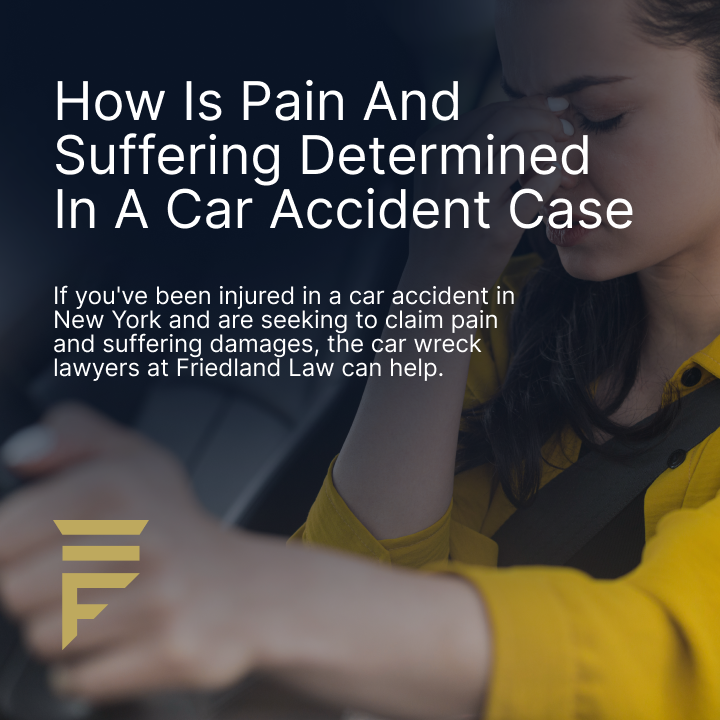
If you’ve been involved in a car accident in New York, it’s crucial to understand how pain and suffering damages are calculated, as they can significantly impact the compensation you receive. Unlike medical expenses and property damage, which have clear, tangible costs, pain and suffering refers to the emotional, physical, and psychological distress caused by your injuries. This can include everything from chronic pain to anxiety, depression, and the overall impact on your quality of life. In this post, we’ll explore how pain and suffering is determined in car accident cases in New York, the types of evidence used to prove it, and how a car accident lawyer at Friedland Law can help you navigate this complex process.
What is Pain and Suffering in Car Accident Cases?
Pain and suffering refers to the physical pain, emotional distress, mental anguish, and loss of enjoyment of life experienced by a person due to injuries sustained in a car accident. This is a non-economic damage, meaning it’s not directly tied to monetary losses like medical bills or lost wages, but it is just as significant in assessing the full impact of the accident on the injured person.
How is Pain and Suffering Calculated in New York?
Pain and suffering damages are not straightforward, and New York law uses several methods to calculate these damages. These methods aim to estimate the emotional and physical toll the accident has on your life.
Economic vs. Non-Economic Damages
Economic damages cover quantifiable losses like medical expenses, lost wages, and property damage.
Non-economic damages include pain and suffering, and are more difficult to quantify because they are subjective in nature. Non-economic damages can vary widely based on the nature and extent of your injuries.
Multiplier Method
One common approach to calculating pain and suffering is the multiplier method. In this method, the total of your economic damages (like medical bills and lost wages) is multiplied by a number between 1.5 and 5, depending on the severity of your injuries. The more severe your injuries, the higher the multiplier. For instance, if your economic damages are $20,000 and your injuries are considered moderate, a multiplier of 2 might be applied, resulting in $40,000 in pain and suffering damages.
Per Diem Method
The per diem method is another way to calculate pain and suffering. This method involves assigning a daily rate to the pain and suffering you endure and then multiplying that by the number of days you experience the pain. Typically, the daily rate is based on your average daily earnings or an amount determined by your lawyer. For instance, if your daily pain and suffering rate is calculated to be $150, and you suffer for 180 days, your total pain and suffering damages would be $27,000. This method is more straightforward than the multiplier approach but still requires careful consideration of the severity and duration of your suffering.
Factors Influencing Pain and Suffering Determination
Several factors influence how pain and suffering damages are determined in a car accident case. These factors help paint a picture of how the accident has affected your life both physically and emotionally.
Injury Severity
The more severe and long-lasting the injury, the higher the potential for pain and suffering damages. For example, injuries like traumatic brain injuries (TBI) or spinal cord injuries often result in long-term, debilitating pain and can dramatically increase the pain and suffering award.
Recovery Duration
The length of time required for recovery also plays a significant role. If your recovery period is prolonged or if you experience chronic pain after healing, these factors can increase the damages you may be entitled to.
Long-Term Injury Effects
Injuries that have long-term or permanent consequences, such as permanent disability or chronic pain, may lead to higher pain and suffering awards. For instance, if your injuries are expected to affect your quality of life for years to come, you may be entitled to a greater settlement.
Evidence for Proving Pain and Suffering
Since pain and suffering are non-economic damages, proving them can be challenging. Below are key types of evidence commonly used to support a claim for pain and suffering:
Medical Records Detailing Injuries
Medical records are essential in documenting the extent of your physical injuries. These records provide a clear and objective account of your treatment, diagnoses, and prognosis, which help establish the connection between your injuries and the pain you are experiencing.
Expert Testimony on Psychological Impact
In many cases, expert testimony from psychologists, psychiatrists, or other mental health professionals may be used to establish the psychological toll of the accident. Depression, anxiety, and post-traumatic stress disorder (PTSD) are common psychological effects of car accidents, and expert testimony can help validate these claims.
Personal Diaries on Daily Pain
Keeping a pain diary can provide valuable evidence of how your injuries affect your daily life. Detailed notes on the level of pain you experience, how it interferes with work or personal activities, and any emotional distress you endure can help illustrate the ongoing suffering caused by the accident.
New York Laws and Pain Suffering Awards
New York’s legal framework for pain and suffering damages includes several unique aspects, including no-fault insurance laws and specific thresholds for filing personal injury lawsuits.
No-Fault Insurance Implications
In New York, the no-fault insurance system means that your own insurance company will typically pay for your medical bills and lost wages, regardless of who caused the accident. However, this system does not cover pain and suffering unless your injuries meet a certain severity threshold.
Serious Injury Threshold Explained
Under New York’s no-fault law, you must meet the serious injury threshold to file a lawsuit for pain and suffering. This means your injuries must be serious enough to warrant a legal claim, such as fractures, disfigurement, significant loss of body function, or death.
Comparative Negligence and Its Effect
New York follows the comparative negligence rule, which means that if you are partially at fault for the accident, your pain and suffering damages may be reduced by your percentage of fault. For instance, if you are 20% at fault for the crash, your total pain and suffering award could be reduced by 20%.
Steps to Claim Pain and Suffering Damages
If you’ve been involved in a car accident, it’s important to follow certain steps to ensure your claim for pain and suffering is properly documented and pursued.
Immediate Accident and Injury Reporting
Always report the accident to the police and make sure your injuries are documented at the scene. This is critical for any future legal claims.
Prompt Medical Attention for Documentation
Seek medical attention immediately, even if your injuries seem minor. A healthcare professional will document your injuries and create a record that is essential for proving your pain and suffering later.
Hiring an Auto Accident Attorney
Consulting with a qualified car wreck attorney, such as those at Friedland Law, can ensure that you take the right steps to protect your rights and maximize your compensation.
Role of Personal Injury Attorneys in Claims
A personal injury attorney plays a crucial role in ensuring that you receive a fair settlement for your pain and suffering.
Legal Strategy Development
A skilled lawyer will help you develop a strategy for pursuing your claim, considering the best methods for calculating and proving your damages.
Negotiating with Insurance Companies
Insurance companies often try to minimize payouts, but an experienced attorney will advocate for your interests and negotiate for the compensation you deserve.
Representing Clients in Court
If your case goes to trial, your attorney will represent you in court, presenting evidence and arguing your case before a judge and jury.
Challenges in Proving Pain and Suffering
There are several challenges in proving pain and suffering claims, particularly because these damages are subjective.
Subjectivity of Non-Economic Damages
Pain and suffering are subjective experiences, which can make it difficult to determine a specific value for these damages.
Insurance Company Resistance
Insurance companies often try to minimize pain and suffering claims, making it important to have a lawyer who can counter these efforts with strong evidence.
Gathering Comprehensive Evidence
Proving pain and suffering requires detailed evidence, including medical records, expert testimony, and personal accounts. Gathering this evidence can be time-consuming and challenging without legal assistance.
Importance of Documentation in Claims
Detailed Medical Record Importance
Medical records will provide a clear and consistent timeline of your injuries and treatment, which supports your claim.
Keeping a Pain Diary
A personal pain diary can be an invaluable tool in documenting the daily effects of your injuries.
Collecting Witness Statements
Witness statements from people who observed your pain or daily struggles can further validate your claim.
Let Us Fight for You – Schedule a Free Consultation Today!
If you’ve been injured in a car accident in New York and are seeking to claim pain and suffering damages, the car wreck lawyers at Friedland Law can help. We offer free consultations to discuss your case, understand the full scope of your injuries, and determine the best legal strategy for you. Let us fight for the compensation you deserve.





